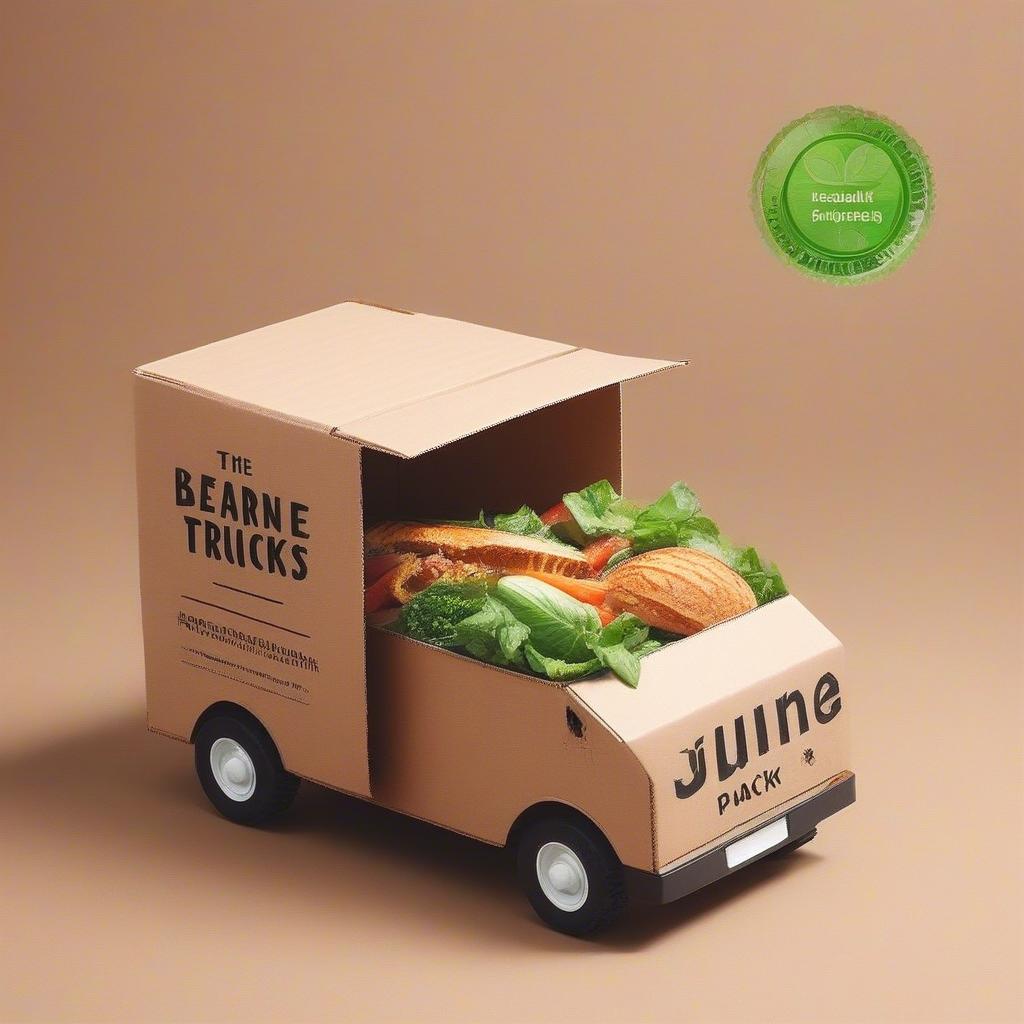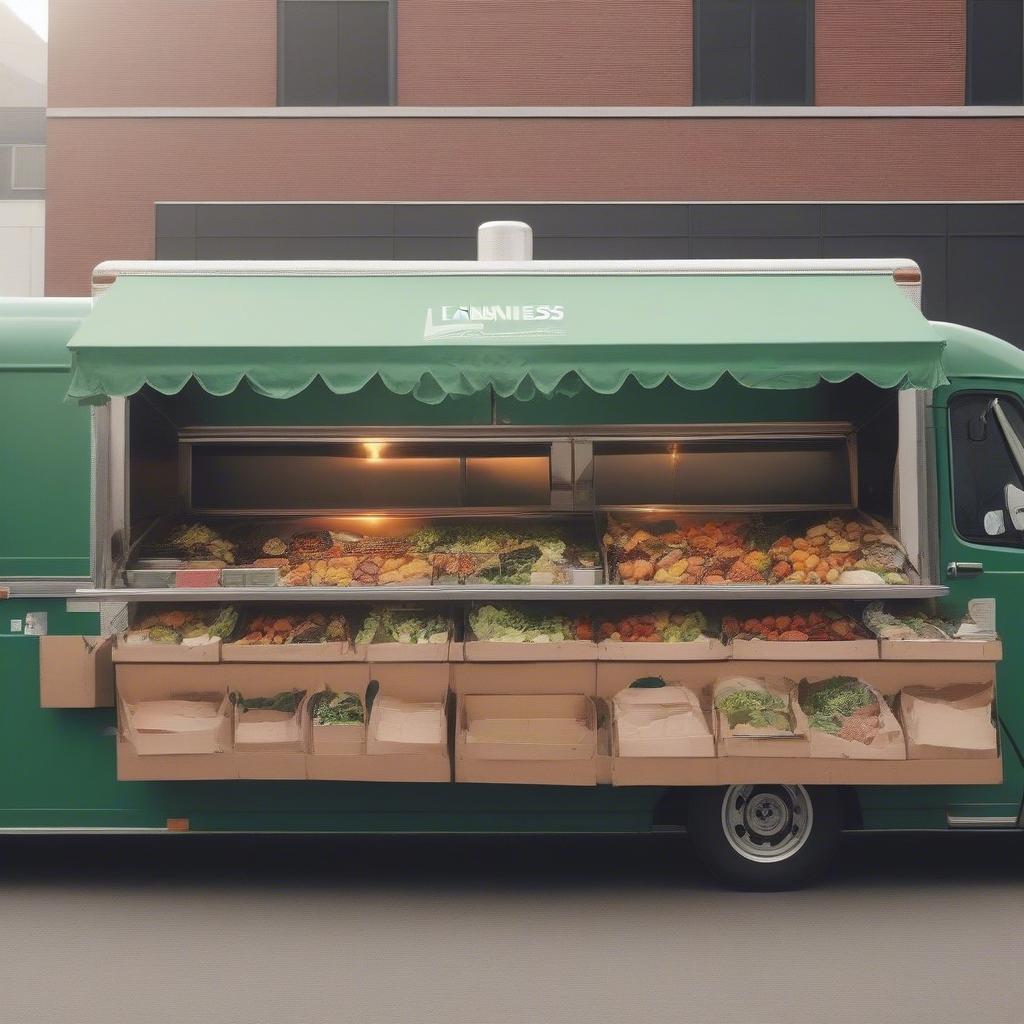
10 Creative Food Truck Branding Ideas for 2025
The Power of a Standout Food Truck Brand
In the bustling world of mobile food, your food truck isn’t just a vehicle; it’s a rolling billboard, a miniature restaurant, and a powerful brand ambassador. In 2025, with increased competition and savvy consumers, merely having delicious food won’t cut it. You need creative branding that captures attention, builds loyalty, and sets you apart. This article explores 10 innovative food truck branding ideas designed to make your business thrive in the modern market. Think beyond just a logo; we’re diving into the heart of what makes a memorable, magnetic brand. We’re focusing on the ‘why,’ not just the ‘what.’
Why Branding Matters More Than Ever for Food Trucks
Branding is not just about looking pretty; it’s about forging a connection with your customers. It’s about creating an experience that extends beyond the food itself. Effective food truck branding accomplishes several critical goals:
- Differentiation: In a saturated market, a strong brand helps you stand out from the crowd. It answers the question: “Why choose you?”.
- Recognition: A consistent brand builds recognition and makes it easier for customers to remember and recommend you.
- Loyalty: A compelling brand fosters an emotional connection with customers, turning them into loyal patrons.
- Premium Perception: Good branding can help you justify premium pricing, even if your competitors offer similar food at a lower cost.
- Memorability: A distinct brand creates a lasting impression, increasing the chances of repeat business and positive word-of-mouth marketing.
1. Embrace Storytelling: Craft Your Food Truck Narrative
People connect with stories. Instead of just selling food, sell your narrative. Consider these elements to build a compelling story for your food truck branding:
- Origin Story: Where did your passion for food come from? Share your journey – from childhood dreams to culinary adventures. Was there a family recipe, a travel experience, or a personal struggle that inspired your food truck?
- Unique Ingredients: Do you source your ingredients locally? Use heirloom recipes? Highlight the uniqueness of your ingredients and processes.
- Inspiration: What inspires your menu? Is it a specific culture, a childhood memory, or a personal belief? Share the ‘why’ behind your culinary choices.
- Personal Connection: Let your personality shine! Share anecdotes, behind-the-scenes moments, and your team’s passion. Humanize your brand.
The “Why”: People don’t buy what you do, they buy why you do it. Define your mission and share it genuinely.
Example: Imagine a food truck called “Grandma Rosa’s Empanadas”. They don’t just sell empanadas; they sell the story of a family recipe passed down through generations, using locally sourced ingredients and a commitment to authentic flavors.
Actionable Tip: Develop a short “About Us” section for your website and social media. Consider including a video that brings your story to life. Use your story across all food truck marketing materials.
Building Your Story
* **Brainstorm:** Jot down key moments, inspirations, and values that define your brand.
* **Craft:** Weave these elements into a cohesive narrative that resonates with your target audience.
* **Share:** Integrate your story across all touchpoints, from your menu to your website, social media, and even casual conversations with customers.
2. The Power of Visual Identity: Beyond the Logo
Your visual identity is the face of your brand. It’s what people see and remember. Here’s how to make your visual identity impactful for food truck branding :
- Color Palette: Choose a color palette that reflects your brand personality. Is it vibrant and energetic, or calm and sophisticated? Ensure the colors evoke the right feeling.
- Typography: Select fonts that are legible and aligned with your brand’s aesthetic. Don’t use too many fonts; consistency is key.
- Logo Design: Invest in a professionally designed logo that is memorable and adaptable for various uses, from the truck wrap to social media.
- Imagery: Use high-quality photos of your food and truck. Make sure they’re well-lit, visually appealing, and consistent with your brand aesthetic.
Truck Wrap: Your truck is your biggest marketing tool. Design a wrap that’s eye-catching, professional, and reflective of your brand.
Example: A food truck serving vegan cuisine might use a color palette of earthy greens and natural browns with a clean, modern font and imagery focused on fresh ingredients.
Actionable Tip: Create a style guide that outlines your brand’s visual elements for consistency across all platforms. This includes your colors, typography, logo variations, and photography style. Use templates for your food truck marketing materials to maintain visual harmony.
Developing Your Visual Identity
* **Mood Board:** Gather images, colors, and fonts that resonate with your brand.
* **Design:** Hire a professional designer to create a logo and visual elements that align with your mood board.
* **Consistency:** Ensure all visual elements are used consistently across all platforms to create a cohesive brand identity.
3. Experiential Branding: Create a Memorable Encounter
Branding isn’t just visual; it’s also about the experience you provide. Here’s how to create an unforgettable experience for your customers:
- Unique Packaging: Think beyond generic containers. Design packaging that’s eco-friendly, visually appealing, and functional. It can even reflect your brand theme.
- Themed Service: Train your staff to interact with customers in a way that is consistent with your brand. A friendly, efficient, and engaging team elevates the experience.
- Special Events: Host themed events, offer special menus, or create limited-time offers to keep your brand fresh and exciting.
- Engaging Interactions: Offer free samples, ask for customer feedback, and remember regular customers’ names to create a personal connection.
Ambiance: Consider the surroundings when you set up. Adding small touches like lighting, music, and seating (where possible) can enhance the overall experience.
Example: A taco truck might offer vibrant, hand-painted taco trays, while a dessert truck could present their treats in custom-designed boxes with a ribbon.
Actionable Tip: Regularly evaluate your customer experience. Collect feedback and make adjustments to create a more seamless and enjoyable interaction. Experiment with different themes and offers to keep things exciting for your customers. Consider using a digital feedback form to gather data efficiently.
Elevating the Customer Experience
* **Map:** Outline the entire customer journey, from discovery to purchase.
* **Enhance:** Identify opportunities to improve each touchpoint for a more engaging and memorable interaction.
* **Iterate:** Regularly collect customer feedback to continuously improve the overall experience.
4. Location-Based Branding: Embrace Your Community
Integrate your brand with the locations where you operate. Being part of the community can enhance your brand appeal:
- Local Sourcing: Highlight partnerships with local farmers or producers. This reinforces your commitment to quality and community support.
- Community Events: Participate in local markets, festivals, and events. It’s a great way to connect with your target audience.
- Localized Menu Items: Create menu items that incorporate local ingredients or flavors, showcasing your unique connection to the area.
- Partnerships: Collaborate with other local businesses to cross-promote your brand and extend your reach.
Community Giveback: Organize events to support local charities or organizations. Showing that your brand cares about the community strengthens your brand image.
Example: A food truck in a coastal town might feature fresh seafood from local fishermen and partner with local surf shops for cross-promotions.
Actionable Tip: Research local events and initiatives where you can get involved. Actively participate in community conversations on social media, showcasing your local roots.
Becoming a Part of the Community
* **Research:** Identify local events, markets, and initiatives in your operating area.
* **Engage:** Participate actively in your community to build relationships and promote your brand.
* **Support:** Show your support for local causes and businesses to enhance your brand image.
5. Digital Presence: Maximize Online Engagement
In the digital age, your online presence is just as important as your physical one. Here’s how to maximize your digital reach with creative food truck marketing:
- Website: Your website should be mobile-friendly, easy to navigate, and informative. Include your menu, location, hours of operation, and story.
- Social Media: Use platforms like Instagram, Facebook, and TikTok to share engaging content, such as photos of your food, behind-the-scenes glimpses, and customer testimonials.
- Online Ordering: Offer online ordering and delivery options for added convenience. Partner with food delivery apps to expand your reach.
- Geo-Targeted Ads: Utilize online advertising to target specific geographic areas where you operate. Run promotions tailored to different locations.
Email Marketing: Build an email list and send out regular updates about new menu items, promotions, and events.
Example: A food truck could use Instagram to share mouthwatering food photos and reels, TikTok to showcase the food preparation process, and Facebook to announce event locations and operating hours.
Actionable Tip: Create a content calendar to plan your social media posts in advance. Use analytics tools to track your progress and refine your strategy. Respond to comments and messages promptly to foster engagement.
Creating a Strong Digital Footprint
* **Optimize:** Ensure your website is mobile-friendly, easy to navigate, and optimized for SEO.
* **Engage:** Use social media platforms to share content that resonates with your target audience and engage with your followers.
* **Track:** Monitor your online performance using analytics tools to refine your strategy and improve your results.
6. Interactive Branding: Engage with Your Audience
Make your brand an experience that involves your customers. Interactive elements create a more engaging and memorable experience:
- Polls and Quizzes: Use social media to ask customers about their food preferences or create fun quizzes related to your brand.
- Photo Contests: Run photo contests where customers can share photos of their meals using a branded hashtag.
- Create Branded Games: Design interactive games on social media or your website that relate to your brand or menu.
- Live Streams: Use live streams to show your food prep process, answer questions, or host virtual events.
QR Codes: Include QR codes on your truck and packaging that link to your menu, social media, or special offers.
Example: A food truck might host a social media contest where customers can submit a funny caption about a picture of their food, or run a poll asking what new item they’d like to see on the menu.
Actionable Tip: Choose interactive elements that align with your brand and are appropriate for your target audience. Promote these interactions through your social media channels and in person at your truck.
Making Branding Interactive
* **Plan:** Identify interactive elements that resonate with your brand and are engaging for your target audience.
* **Promote:** Encourage participation through your social media channels and at your food truck.
* **Analyze:** Track the results of interactive campaigns and refine your strategy for future engagement.
7. Sustainability and Ethical Branding: Align with Values
Consumers are increasingly drawn to brands that align with their values. Showcase your commitment to sustainability and ethical practices:
- Eco-Friendly Packaging: Opt for biodegradable, compostable, or reusable packaging.
- Sustainable Sourcing: Highlight your commitment to sourcing ingredients from local farms that follow sustainable practices.
- Reduce Waste: Implement measures to reduce waste, such as composting, recycling, and using reusable containers.
- Ethical Labor Practices: Ensure fair wages and safe working conditions for your staff.
Transparency: Be transparent about your practices. Share your sustainability goals with your customers.
Example: A food truck could use plant-based packaging, compost food waste, and highlight its partnership with a local farm that practices organic farming.
Actionable Tip: Communicate your sustainability and ethical efforts on your website, social media, and at your food truck. Offer options that appeal to environmentally conscious consumers, such as discounts for bringing reusable containers.
Committing to Sustainability
* **Assess:** Identify areas where your operations can be made more sustainable and ethical.
* **Implement:** Adopt sustainable practices in packaging, sourcing, and waste management.
* **Communicate:** Clearly share your sustainability efforts with your customers to build trust and brand loyalty.
8. Personalization and Customization: Tailor the Experience
Offer options that allow customers to personalize their experience with your brand and offerings:
- Customizable Menu Items: Offer options for customers to choose their toppings, sauces, or spice levels.
- Personalized Recommendations: Use past purchase history or preferences to offer tailored menu suggestions.
- Branded Merchandise: Offer merchandise like hats, t-shirts, or stickers that customers can personalize with their own style.
- Loyalty Programs: Implement a loyalty program that rewards repeat customers and provides personalized offers.
Interactive Kiosks: Use interactive kiosks to allow customers to build their meals according to their preferences.
Example: A burger truck might let customers pick their bun, patty, cheese, and toppings, or a coffee truck could offer a custom blend option.
Actionable Tip: Start small with one or two personalization options, then expand based on customer feedback. Use customer data to make personalized recommendations.
Personalizing Your Customer Experience
* **Offer:** Provide options for customers to personalize their menu items.
* **Recommend:** Use data to provide tailored recommendations based on past purchases and preferences.
* **Reward:** Implement a loyalty program to reward loyal customers with exclusive offers and personalized service.
9. Consistent Branding: Maintain a Unified Message
Consistency is paramount for a cohesive and recognizable brand. Your message should be the same across all platforms and interactions:
- Brand Voice: Develop a distinct brand voice. Is it playful, friendly, professional, or sophisticated?
- Messaging: Ensure that all your communication, from your menu descriptions to social media posts, carries your brand’s message consistently.
- Customer Service: Train your staff to use consistent language and messaging when interacting with customers.
- Visuals: Maintain consistent use of your logo, colors, fonts, and imagery across all platforms.
Experience: The overall feel and experience should be consistent whether a customer visits your truck in person or interacts with you online.
Example: If your brand is fun and playful, use casual language, emojis, and bright colors consistently in your social media posts and in-person interactions.
Actionable Tip: Create a brand style guide for your team to use. Conduct regular audits to ensure that your brand message is being consistently applied across all platforms and interactions.
The Importance of Consistency
* **Develop:** Define your brand voice and messaging to ensure all communication is consistent.
* **Educate:** Train your staff to use consistent language and brand messaging when interacting with customers.
* **Audit:** Conduct regular audits to ensure consistency across all platforms and interactions.
10. Adaptability and Innovation: Stay Ahead of the Curve
The market is constantly evolving. A brand that’s adaptable and innovative is more likely to thrive:
- Stay Updated: Keep up with the latest trends in the food industry and food truck marketing.
- Experiment: Be open to trying new menu items, branding tactics, or service styles.
- Customer Feedback: Continuously seek feedback from your customers and use it to refine your offerings and branding.
- Technological Innovation: Be open to using new technologies, such as online ordering systems, mobile payment options, and interactive kiosks.
Seasonal Offerings: Introduce new menu items that align with seasonal trends or local ingredients.
Example: A food truck could offer a vegan version of their classic burger when they notice an increased interest in plant-based options, or incorporate new social media trends into their content strategy.
Actionable Tip: Dedicate time for research and experimentation. Be willing to make adjustments based on performance metrics. Embrace a mindset of continuous improvement and learning.
Remaining Adaptable
* **Research:** Stay updated on industry trends and innovations.
* **Experiment:** Be open to testing new ideas and approaches to branding and your menu.
* **Evolve:** Continuously adapt your business based on customer feedback and performance data.
Learn Business: Your Partner in Food Truck Success
At Learn Business, we understand the challenges faced by entrepreneurs in the food truck industry. That’s why we offer a comprehensive suite of resources and support to help you launch and grow your business successfully.
How Learn Business Supports Your Food Truck Branding Journey
- Business Planning Templates: Our comprehensive templates will guide you through every step of the planning process, from creating a solid business plan to defining your brand identity.
- Marketing Guides: Get access to effective marketing strategies and templates tailored to the food truck industry, helping you attract and retain customers.
- Financial Tools: Manage your finances effectively using our user-friendly tools and templates, ensuring you stay on top of your business’s financial health.
- Legal Resources: Understand the legal requirements and regulations for operating a food truck in your area. Our legal resources will help you stay compliant.
- Personalized Guidance: Benefit from expert advice and personalized guidance to help you navigate the complexities of the food truck industry. We will help you develop a creative branding strategy that sets you apart.
We are committed to helping you turn your culinary dreams into a thriving business. By leveraging the resources provided by Learn Business, you will be well-equipped to build a memorable, engaging, and profitable food truck brand.
Conclusion:
Building a successful food truck brand in 2025 requires more than just great food. It requires a cohesive and creative branding strategy that encompasses your story, visual identity, customer experience, digital presence, and commitment to your community. By implementing these 10 creative branding ideas, you will not only stand out from the competition but also build a loyal customer base that will support your business for years to come. Remember that your brand is your promise to your customers; make sure it’s a promise they can rely on and rave about.



Leave a Reply